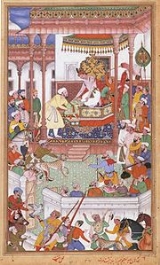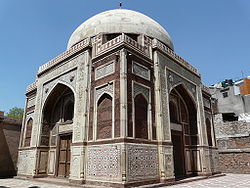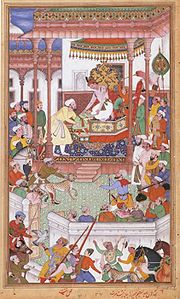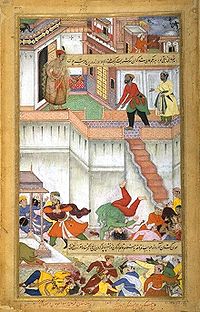
Ataga Khan
Encyclopedia
Shamsuddin Muhammad Atgah Khan (Ataga Khan) (died 1562), also known as Khan-e-Kalan Shamsu'd-Din Muhammad Khan Atgah Khan, held important positions in the court, including that of wakil (advisor or minister) to which he was appointed in November 1561,much to displeasure of Maham Anga
, whose son Adham Khan
, eventually murdered him in 1562. Ataga Khan was the husband of Ji Ji Anga, one of Akbar's wet nurse
s.
Shamsuddin was the son of Mir Yar Muhammad of Ghazni, a simple farmer, and started life as a soldier in Kamran Mirza
’s army. He saved Humayun
from drowning in the Ganges. As reward, Humayun took him into his personal service and his wife became one of Akbar's foster-mothers. She was called foster-mother( Anagah) and her husband Shamsuddin was designated foster-father (Atgah). He also received the title of Khan
and his biological son, Aziz became Akbar's foster or milk-brother (Kokah) .
 On May 16, 1562, Adham Khan
On May 16, 1562, Adham Khan
accompanied by a few ruffians burst in upon him as he sat in the Diwan-e-Aam, the hall of audience, in Agra Fort
, and murdered him, in the courtyard of Diwan-e-Aam.. Hearing of this murder, an enraged Akbar ordered Adham Khan to be thrown down the rampart of the fort, and when he survived the first fall, he was thrown a second time and killed instantly.
After the death of Ataga Khan, his tomb was built by the instructions of Mughal emperor Akbar and built by his son, Mirza Aziz Koka, in 1566-67. It is situated on the northern edge of Nizamuddin, most known for the dargah
of 13th century Sufi saint Nizamuddin Auliya
. Its architect was Ustab Khuda Quli and calligrapher Baqi Muhammad from Bukhara
, who added Quranic verses on the white marble slabs, inlaid on the red sandstone exterior walls, which were suitably chosen reflecting his mode of death, considered a martyrdom by Mughal historian, Abul Fazal
. An inscription on the southern door of the tomb mentions that it was finished in 974 AH (1566–67).
Maham Anga
Maham Anga was the wet nurse of the Mughal Emperor Akbar, and often referred as his foster mother as she took care of young Akbar, as his own mother, Hamida Banu Begum was mostly away, with his father, Humayun was in exile, throughout Akbar's growing years...
, whose son Adham Khan
Adham Khan
Adham Khan was a general of Akbar. He was the younger son of Maham Anga, he thus became the foster brother of Akbar. In his fourth regnal year, Akbar married him to the daughter of Baqi Khan Baqlani.-Conquest of Malwa:...
, eventually murdered him in 1562. Ataga Khan was the husband of Ji Ji Anga, one of Akbar's wet nurse
Wet nurse
A wet nurse is a woman who is used to breast feed and care for another's child. Wet nurses are used when the mother is unable or chooses not to nurse the child herself. Wet-nursed children may be known as "milk-siblings", and in some cultures the families are linked by a special relationship of...
s.
Shamsuddin was the son of Mir Yar Muhammad of Ghazni, a simple farmer, and started life as a soldier in Kamran Mirza
Kamran Mirza
Kamran Mirza, sometimes known simply as Kamran, was the second son of Babur Mirza, the founder of the Mughal dynasty.Kamran Mirza was born in Kabul...
’s army. He saved Humayun
Humayun
Nasir ud-din Muhammad Humayun was the second Mughal Emperor who ruled present day Afghanistan, Pakistan, and parts of northern India from 1530–1540 and again from 1555–1556. Like his father, Babur, he lost his kingdom early, but with Persian aid, he eventually regained an even larger one...
from drowning in the Ganges. As reward, Humayun took him into his personal service and his wife became one of Akbar's foster-mothers. She was called foster-mother( Anagah) and her husband Shamsuddin was designated foster-father (Atgah). He also received the title of Khan
Khan (title)
Khan is an originally Altaic and subsequently Central Asian title for a sovereign or military ruler, widely used by medieval nomadic Turko-Mongol tribes living to the north of China. 'Khan' is also seen as a title in the Xianbei confederation for their chief between 283 and 289...
and his biological son, Aziz became Akbar's foster or milk-brother (Kokah) .
 |
 |
Death

Adham Khan
Adham Khan was a general of Akbar. He was the younger son of Maham Anga, he thus became the foster brother of Akbar. In his fourth regnal year, Akbar married him to the daughter of Baqi Khan Baqlani.-Conquest of Malwa:...
accompanied by a few ruffians burst in upon him as he sat in the Diwan-e-Aam, the hall of audience, in Agra Fort
Agra Fort
Agra Fort, is a monument situated at Agra, is a UNESCO World Heritage site located in Agra, Uttar Pradesh, India. It is about 2.5 km northwest of its more famous sister monument, the Taj Mahal...
, and murdered him, in the courtyard of Diwan-e-Aam.. Hearing of this murder, an enraged Akbar ordered Adham Khan to be thrown down the rampart of the fort, and when he survived the first fall, he was thrown a second time and killed instantly.
After the death of Ataga Khan, his tomb was built by the instructions of Mughal emperor Akbar and built by his son, Mirza Aziz Koka, in 1566-67. It is situated on the northern edge of Nizamuddin, most known for the dargah
Nizamuddin Dargah
Nizamuddin Dargah is the dargah of one of the world's most famous Sufi saints, Nizamuddin Auliya. Situated in the Nizamuddin West area of Delhi, the dargah is visited by thousands of Muslims every week, and sees a fair share of Hindus, Christians and people from other religions...
of 13th century Sufi saint Nizamuddin Auliya
Nizamuddin Auliya
Sultan-ul-Mashaikh, Mehboob-e-Ilahi, Hazrat Shaikh Khwaja Syed Muhammad Nizamuddin Auliya , also known as Hazrat Nizamuddin, was a famous Sufi saint of the Chishti Order in the Indian Subcontinent, an order that believed in drawing close to God through renunciation of the world and service to...
. Its architect was Ustab Khuda Quli and calligrapher Baqi Muhammad from Bukhara
Bukhara
Bukhara , from the Soghdian βuxārak , is the capital of the Bukhara Province of Uzbekistan. The nation's fifth-largest city, it has a population of 263,400 . The region around Bukhara has been inhabited for at least five millennia, and the city has existed for half that time...
, who added Quranic verses on the white marble slabs, inlaid on the red sandstone exterior walls, which were suitably chosen reflecting his mode of death, considered a martyrdom by Mughal historian, Abul Fazal
Abu'l-Fazl ibn Mubarak
Shaikh Abu al-Fazl ibn Mubarak also known as Abu'l-Fazl, Abu'l Fadl and Abu'l-Fadl 'Allami was the vizier of the great Mughal emperor Akbar, and author of the Akbarnama, the official history of Akbar's reign in three volumes, and a Persian translation of the Bible...
. An inscription on the southern door of the tomb mentions that it was finished in 974 AH (1566–67).

